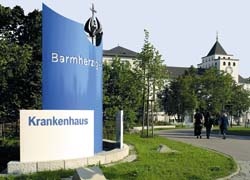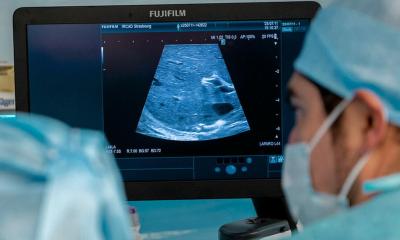TELEMEDICINE
Transforming operating theatre communication and surgical education
Germany - The Barmherzigen Brüder Hospital in Regensburg, serves the populations of Lower Bavaria and the Upper Palatinate. 20 years ago, this hospital had only three operating theatres; today there are sixteen

Due to the constant increase in the complexity of demands placed on the medical staff as well as the technical equipment in the operating theatre (OT), the Barmherzigen Brüder Hospital has decided to customise the operating theatres for the respective specialist areas. The focus on the OT set-up supports the problem-free workflow for physicians and medical personnel. ‘With a view to the medical technology in particular, stable conditions are created through specialisation. On the other hand, this benefits the personnel, who then operate a smaller range of devices and know exactly how to deploy these in an optimum manner. On the other, in the event of a technical malfunction we can quickly find the source of the error,’ explained Uwe Kleineidam, head of the OT wing.
The standardisation of medical technology devices in the OTs at a high technical level with simultaneous deployment of integrated complete solutions also contributes to the simplification of the workflow.
An integrated complete solution
In 2008, with the expansion of the existing central OT wing to include three new OTs, a system from Maquet was used for the first time. With the surgical table system AlphaMaquet 1150, the PowerLED 700 surgical lights and the key component, a Telemedicine system, the essential elements of the OT were brought together to form an individual complete solution. All the devices are tailored to the specific needs of the surgeon and his team. The upgradeability of the individual modules and the possibility for problem-free expansion of the entire system offer the best-possible investment protection, Maquet points out. The fully IT-based telemedicine system is easily accommodated by the existing IT landscape of the hospital and supports all the customary hardware and software interfaces.
The factor that tipped the scales in favour of Maquet’s Telemedicine System was this holistic integrated approach with the specification that all patient-relevant data and images sources be brought together at a central location and made available in the OT. For Ulrich Kiesskalt, the head of the biomedical technology and investment goods procurement department, this is an important step towards implementing the multimedia operating theatre: ‘The interplay of all the individual links in the process chain is the decisive criterion. There has to be compatibility and the quality has to remain at a consistently high level throughout the entire process.’
The Telemedicine System in thoracic surgery
With two high-definition monitors (19”) installed above the surgical table, the self-explanatory touch-screen and the basic element AV Conference, the Telemedicine System meets the high demands placed on its use in thoracic surgery, Maquet reports.
Ulrich Kiesskalt: ‘This development optimises the ergonomics at the workstation. In the past it was difficult for surgeons to view the operating area, now the physician and the OT team can follow the events at the surgical table via the fixed monitors of the telemedicine System. Communication is no longer simply verbal for the main part, but also optical.’ An authentic visual portrayal of events at the operating table is also growing in significance with a view to minimally invasive surgery (MIS).
Professor Hans-Stefan Hofmann, senior consultant in the clinic for thoracic surgery, is convinced by the advantages of a fixed monitor: ‘Previously we had a mobile system, something that is totally impractical for the surgeon because only one person can see clearly during surgery. In principle you need two monitors.’
The monitors are installed on space-saving ceiling service units and can be positioned individually.
Thanks to the professional documentation and archiving function of the system, in the future images, videos and patient data will be stored centrally in the PACS and the hospital information system (HIS). These may be viewed directly in the theatre at the push of a button.
As the University of Regensburg teaching hospital numerous further training events are offered for the theatre, which may be followed from different angles. ‘We don’t just work with the endoscopic unit, but also with the light and room camera. At the same time, we use the microphone function for communication with the audience,’ said Prof Hofmann.
Conclusion and outlook
With the commissioning of the new OT for thoracic surgery in June 2008 the benefits of an integrated theatre system have already become clear: The positive impact on ergonomics, communication and the entire theatre workflow are reflected in the enhanced transparency and efficiency, and thus ultimately in improved patient care.
Following its positive experiences, Maquet reports that The Barmherzigen Brüder Hospital will install the Telemedicine System and PowerLED 700 surgical lights in the visceral surgery theatre.
01.03.2009











